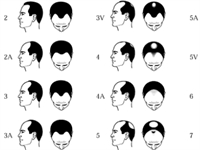
Folicular Unit Transplant (FUT) vs. Folicular Unit Extraction (FUE)
Important Notice: Our web hosting provider recently started charging us for additional visits, which was unexpected. In response, we're seeking donations. Depending on the situation, we may explore different monetization options for our Community and Expert Contributors. It's crucial to provide more returns for their expertise and offer more Expert Validated Answers or AI Validated Answers. Learn more about our hosting issue here.

Folicular Unit Transplant (FUT) vs. Folicular Unit Extraction (FUE)
You must be logged in to post a comment.
Back in the 1980s, men who were losing their hair chose one of three grim options: go bald, wear a toupee, or undergo surgery for hair plugs that made their scalp resemble a doll’s head.
With advancements in medicine and technology, men with shiny scalps can choose from an array of surgical, medicinal and topical hair treatments to try to keep and regrow their hair with a natural looking appearance.
Among these, hair transplant surgery is the only permanent solution to hair loss, in particular Follicular Unit Transplantation and Follicular Unit Extraction.
The procedures involve harvesting "donor" hair from the back and sides of the head that is genetically programmed to never go bald, and transplanting it to balding areas for a natural looking appearance.
The procedures differ in how the donor hair is harvested.
Causes of Balding
Despite what you may have heard about baseball caps, your mother’s father and hair gels, male pattern baldness is influenced by genetics and hormones.
A man’s genetic predisposition to baldness can come from either side of the family and can skip generations and siblings, notes Dr. Paul Cotterill, a hair transplant surgeon based in Toronto, Canada.
Once a man develops testosterone after puberty, it turns on the genetic predisposition for baldness.
Male pattern baldness is also known as androgenic alopecia. As a man ages, his body produces a hormone called 5 alpha reductase that converts regular testosterone into dihydrotestosterone (DHT) which shrinks hair follicles until the hair falls out.
Dr. Cotterill notes that by age 50, half of all men experience some form of hair loss.
So what can you do about baldness? Hair transplant surgery is the only permanent solution as it takes DHT-resistant hair from the back and sides of your scalp and transplants it to the balding areas.
Follicular Unit Transplant
The most common hair transplant surgery known as the "strip method," Folicular Unit Transplantation (FUT) involves taking a strip of skin from the back of the head, dissecting it with magnification to isolate the hair follicles, which can have one to four hairs, and then transplanting those follicles into balding areas where small incisions are made for the new follicles to grow.
The procedure can transplant anywhere from several hundred to several thousand hair follicles in a single operation and is an out-patient procedure that involves local anesthesia while the patient is awake.
FUT Pros and Cons
FUT surgery is the most common and most recommended hair transplant surgery because it offers the best "bang for buck." According to the Bernstein Medical Center for Hair Restoration, the FUT procedure allows the surgeon to produce the highest quality grafts by isolating the follicle units with minimal trauma. Also, FUT enables the surgeon to best utilize the most permanent part of the donor area.
Unfortunately, FUT is surgery and the procedure leaves a fine linear scar on the back of the patient’s head and there is some post-op discomfort and swelling for about a week.
Follicular Unit Extraction
For patients who are concerned about having a linear scar, wear their hair very short or their scalp is too tight for strip harvesting, Folicular Unit Extraction (FUE) is also a viable option.
The FUE procedure involves the surgeon extracting each individual hair follicle, which can have one to four hairs, at a time using a hole-punch like instrument and then inserting the follicles into balding areas.
Once the hair follicles are extracted, they are inserted into the balding areas the same way as the FUT procedure.
FUE Pros and Cons
FUE also leaves some scarring resembling more of a punch hole, but is not as noticeable as the FUT’s linear scar. Patients that undergo the FUE recover faster and feel less post-op discomfort and the procedure can also restore other areas such as beards and eye brows.
Because of the more delicate nature of the procedure, FUE takes much longer to perform than FUT and FUE is generally more expensive than FUT.
Considerations
Whether you choose an FUT or FUE procedure, transplanted hair is permanent lifetime hair that resists DHT and will never go bald. However, many men who have had FUT or FUE procedures continue taking medications and topical aids such as Propecia and Rogaine for their native hair. If a patient continues to lose native hair behind the area that is restored, he will have to continue with subsequent transplant procedures.
Although a relatively minor surgery, patients can experience discomfort and swelling following surgery and are advised to follow the surgeon’s orders on recovery and rest.
Cost
FUT or FUE procedures are very expensive and are priced per hair follicle/graft. One hair graft contains one hair follicle and every follicle can have anywhere from one to four hairs and have 2.2 on average.
Hair transplant surgeries can require anywhere from 800 to more than 2,000 individual hair grafts which can cost from $8,000 to more than $20,000 in the United States.
The Norwood Scale determines which stage of male pattern baldness a patient is at and hair transplant specialists can determine how many hair grafts are needed using the scale.
Consult a dermatologist to determine whether a hair transplantation surgery is right for your hairloss and whether an FUE or FUT is best.